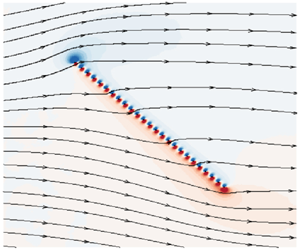Article contents
Aerodynamic response of a bristled wing in gusty flow
Published online by Cambridge University Press: 19 February 2021
Abstract

Some microscopic flying insects have evolved bristled wings. In the low-Reynolds-number regime they reside in, these porous wings perform like membranous wings because the virtual fluid barriers formed by strong viscous diffusion effectively block the gaps between bristles. In this study, the unsteady aerodynamic responses of a two-dimensional bristled wing to a single intermittent head-on gust are investigated numerically for a wide range of the Reynolds number, gust profile and gap width between the bristles. A comparison of a bristled wing with a corresponding flat wing shows that the gap flow alleviates the undesired aerodynamic loading induced by gusts. The Womersley number, which represents the ratio of the gap width to the length scale of unsteady viscous diffusion, is introduced to better characterize the unsteady drag and lift acting on the bristled wing. Under various model conditions, unsteady drag asymptotically converges beyond a specific value of the Womersley number, and unsteady lift exhibits peak values in a limited range of the Womersley number. Because of the linear property of the low-Reynolds-number flow, the unsteady force induced by the intermittent gusty flow is independent of the steady force produced by the basic steady and uniform free stream. For a large Womersley number, the aerodynamic interaction between the bristles is weak under a gusty flow, and thus the unsteady drag and lift forces can be analytically predicted, using the linear superposition approach of the velocity vector perturbed by a single isolated bristle.
JFM classification
- Type
- JFM Papers
- Information
- Copyright
- © The Author(s), 2021. Published by Cambridge University Press
References
REFERENCES
- 15
- Cited by



